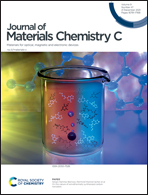The emergence of carbon-dots for optical molecular electronics: from sensors to logic gates, memory devices, and security
Abstract
Carbon-dots (c-dots) have seen tremendous growth in the last decade as an optical sensing probe with applications ranging from metal ion detection, anion detection, disease biomarker detection with in vitro and in vivo applicability as sensors, bioimaging probes, and theranostics. The optical response, primarily the fluorescence turn-off/on signals, enable the use of c-dots as molecular electronics probe. A variety of sensors build using c-dot mimics the Boolean logic and are used to construct AND, OR, XOR, NOR, NAND, IMPLICATION, INHIBIT, YES, NOT, and higher order combinational logic gates. A number of keypad locks and memory elements have also been reported using c-dots. Herein, the molecular electronics potential of c-dots is delineated. The logic operation is discussed with the corresponding chemosensing ability. The applications in the areas of pattern recognition and anti-counterfeiting are also discussed briefly. The high biocompatibility of c-dots adds value to their in vivo applicability and this review envisions c-dot-based logic operation to provide deeper insights into biological studies in the near future.



 Please wait while we load your content...
Please wait while we load your content...